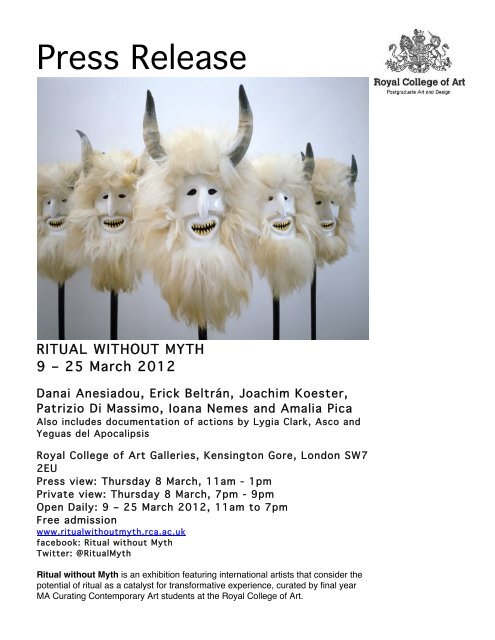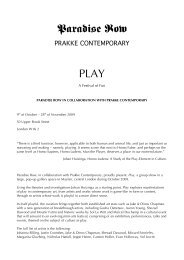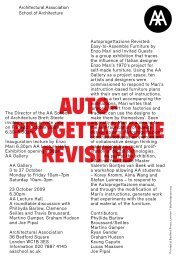Press Release - New Exhibitions of Contemporary Art
Press Release - New Exhibitions of Contemporary Art
Press Release - New Exhibitions of Contemporary Art
Create successful ePaper yourself
Turn your PDF publications into a flip-book with our unique Google optimized e-Paper software.
<strong>Press</strong> <strong>Release</strong><br />
RITUAL WITHOUT MYTH<br />
9 – 25 March 2012<br />
Danai Anesiadou, Erick Beltrán, Joachim Koester,<br />
Patrizio Di Massimo, Ioana Nemes and Amalia Pica<br />
Also includes documentation <strong>of</strong> actions by Lygia Clark, Asco and<br />
Yeguas del Apocalipsis<br />
Royal College <strong>of</strong> <strong>Art</strong> Galleries, Kensington Gore, London SW7<br />
2EU<br />
<strong>Press</strong> view: Thursday 8 March, 11am - 1pm<br />
Private view: Thursday 8 March, 7pm - 9pm<br />
Open Daily: 9 – 25 March 2012, 11am to 7pm<br />
Free admission<br />
www.ritualwithoutmyth.rca.ac.uk<br />
facebook: Ritual without Myth<br />
Twitter: @RitualMyth<br />
Ritual without Myth is an exhibition featuring international artists that consider the<br />
potential <strong>of</strong> ritual as a catalyst for transformative experience, curated by final year<br />
MA Curating <strong>Contemporary</strong> <strong>Art</strong> students at the Royal College <strong>of</strong> <strong>Art</strong>.
The exhibiting artists employ ritual in specific contexts as a means to reveal and<br />
undermine the status quo. The exhibition is a timely reflection on our shifting<br />
relationship to the dominant power structures <strong>of</strong> society and the associated myths<br />
that perpetuate them.<br />
Including newly commissioned and existing contemporary works, as well as<br />
documentation <strong>of</strong> works that have taken place outside a gallery environment, Ritual<br />
without Myth explores art practices that combine cultural repertoires - actions and<br />
symbols that structure social systems - freeing them from the authority <strong>of</strong> a single,<br />
dominant myth.<br />
Several artists are exhibiting work in London for the first time, including a newly<br />
commissioned, large-scale installation by Erick Beltrán (selected for Manifesta 8,<br />
2010 and the 28 th São Paulo Biennial, 2007) and Danai Anesiadou (who participated<br />
in the 5 th Berlin Biennial 2008 and exhibited at Kunsthalle Basel 2011) and the UK<br />
premiere <strong>of</strong> work by Ioana Nemes. The exhibition will also <strong>of</strong>fer the first opportunity<br />
for UK audiences to see together the two iconic 16 mm films by Joachim Koester,<br />
whose work has received acclaim in Documenta X and the Venice Biennale.<br />
The title <strong>of</strong> the exhibition is taken from the idea <strong>of</strong> “rituals without myth” which was<br />
used by the Brazilian artist Lygia Clark to describe her work, in particular Structuring<br />
the Self (1976-1988), a therapeutic practice that explored the affective potential <strong>of</strong><br />
her tactile Relational Objects through the mind and body <strong>of</strong> participants.<br />
The artists share a concern for engaging the viewer as a participant through direct<br />
experience, they formulate confronting visual languages, which they use to upend or<br />
reconfigure ideologies and existing iconographies. Documentation <strong>of</strong> key works that<br />
took place outside the gallery space will further expand on how artists have<br />
addressed the exhibition's themes in social space.<br />
Ritual without Mythʼs media partner is Mousse Magazine<br />
ENDS<br />
For further information or images please contact: Mette Kjaergaard Praest, Curating<br />
<strong>Contemporary</strong> <strong>Art</strong> on email: mette.kjaergaard@network.rca.ac.uk or mobile:<br />
+44(0)75 80381961 or Sue Bradburn, Media Relations Manager on 0207 590 4114;<br />
or sue.bradburn@rca.ac.uk<br />
NOTES TO EDITORS<br />
The MA Curating <strong>Contemporary</strong> <strong>Art</strong> Programme was established in 1992 with<br />
support from <strong>Art</strong>s Council England and is widely acknowledged as an important<br />
marker <strong>of</strong> current developments in contemporary art. The annual CCA show in the<br />
RCA galleries has become known for experimental approaches to working with<br />
artists, and for introducing new international artists to UK audiences.<br />
The Royal College <strong>of</strong> <strong>Art</strong> is the worldʼs most influential postgraduate university <strong>of</strong><br />
art and design, specialising in teaching and research and <strong>of</strong>fering the degrees <strong>of</strong>
MA, MPhil and PhD across the disciplines <strong>of</strong> fine art, applied art, design,<br />
communications and humanities. There are over 1,100 masters and doctoral<br />
students and more than a hundred pr<strong>of</strong>essionals interacting with them – including<br />
scholars, leading art and design practitioners, along with specialists, advisors and<br />
distinguished visitors.<br />
www.rca.ac.uk<br />
About the <strong>Art</strong>ists:<br />
ASCO The Chicano collective made several performances on the streets <strong>of</strong> East<br />
Los Angeles in the 1970s and 80s which appropriated their own Mexican cultural<br />
traditions, like Dia de los Muertos, alongside the language <strong>of</strong> the contemporary<br />
political Chicano muralist movement. In the case <strong>of</strong> Walking Mural (1972), they<br />
physically inhabit this culturally specific imagery, wearing elaborate costumes and<br />
parading solemnly down a busy neighbourhood shopping street.<br />
Danai Anesiadou, Born Germany, 1976. Lives and works in Brussels. In her<br />
performance and installation works Anesiadou layers cultural references with<br />
decoys, ritual and personal biography. Her influences come from left-field popular<br />
culture as well as canonical high culture, and include Chilean filmmaker and spiritual<br />
guru, Alejandro Jodorowsky, ʻpsicomagiaʼ and the evil eye. For this exhibition she<br />
will create a new large-scale installation, which will also serve as the set for a public<br />
performance on Friday 16 March. Her work has previously been seen in the 5th<br />
Berlin Biennial (2008), Wiels (2011) and at Kunsthalle Basel (2011). She was a<br />
recipient <strong>of</strong> the prestigious I.S.C.P. residency in <strong>New</strong> York in 2011.<br />
Further information: http://elisaplatteau.com/artist/danai-anesiadou/<br />
Erick Beltrán. Born Mexico, 1974. Lives and works in Spain and Mexico. Beltránʼs<br />
work integrates different media including installation, writing, performance, sculpture<br />
and printed matter. Through an experimental use <strong>of</strong> diagrams, found objects and<br />
archives, his installations address the way in which symbols and social codes are<br />
defined, valued, classified and reproduced within contemporary societies. For Ritual<br />
without Myth, he has been commissioned to create a large-scale installation that<br />
embodies many <strong>of</strong> these notions, responding to the socially constructed nature <strong>of</strong><br />
ritual and to the exhibition itself. The proposed commission will operate as a<br />
physical intervention in the galleries that will define the ways in which the audience<br />
navigates the exhibition space. Previous exhibitions <strong>of</strong> Beltránʼs work include<br />
Manifesta 8 (2010) and the 28 th São Paulo Biennial (2007).<br />
Further information: http://web.labor.org.mx/en/2011/03/20/erick-beltran/<br />
Lygia Clark. Born, Brazil, 1920 - 1988. Clark studied in Rio de Janeiro and moved<br />
to Paris to study with Fernand Léger in 1950. She was a central figure in Brazil's art<br />
scene in the 1950s and 1960s alongside Hélio Oiticica. Clark was one <strong>of</strong> the key<br />
personalities associated with the Grupo Frente and the Neo-Concretist Manifesto,<br />
and later she explored the healing and therapeutic potential <strong>of</strong> art. Clark <strong>of</strong>ten<br />
described her work as ʻrituals without mythʼ, in particular Structuring the Self, which<br />
took place weekly for up to a year, with single participants drawn from Clarkʼs circle<br />
<strong>of</strong> friends, other artists, local prostitutes and even referrals from psychotherapists.<br />
This took form <strong>of</strong> hour-long sessions involving different objects placed on the body<br />
<strong>of</strong> the participant. No fixed meaning was prescribed to the objects or the<br />
experiences they elicited, instead the content <strong>of</strong> the work — its meaning and
ʻmythologyʼ — was generated by the participant themselves, through their own<br />
subjective experience <strong>of</strong> the ritual.<br />
Joachim Koester. Born Copenhagen, Denmark, 1962. Lives and works<br />
Copenhagen and <strong>New</strong> York. Two silent, 16mm films by Danish artist, Joachim<br />
Koester will initiate viewers to the exhibition. To navigate, in a genuine way, in the<br />
unknown necessitates an attitude <strong>of</strong> daring, but not one <strong>of</strong> recklessness<br />
(movements generated from the Magical Passes <strong>of</strong> Carlos Castañeda), 2009,<br />
demonstrates fictional shamanistic ʻmagical passesʼ, while in I myself am only a<br />
receiving apparatus, 2010, the use <strong>of</strong> a replica <strong>of</strong> Kurt Schwittersʼ Merzbau<br />
resonates with the notion <strong>of</strong> a ritual emptied <strong>of</strong> mythological significance. Koester<br />
has exhibited in the prestigious Documenta X (1997) Biennale di Venezia, Slovenian<br />
Pavilion, Venezia (2007), Italy, and the 29th Sao Paulo Biennale, Brazil (2010).<br />
Furtherinformation:<br />
http://www.nicolaiwallner.com/artists.php?action=details&id=3<br />
Patrizio Di Massimo. Born Jesi, Italy, 1983. Lives and works Amsterdam. Di<br />
Massimo approaches historical facts, artifacts and political symbols in a direct and<br />
affecting way, working across the mediums <strong>of</strong> performance, video, painting and<br />
installation. He is particularly interested in the specific context <strong>of</strong> Italy and the myths<br />
that have arisen from its colonial interventions in Africa. Di Massimo will be<br />
commissioned to create a new work for Ritual without Myth and an existing film by<br />
the artist will be shown at a screening event on Friday 16 March. He is currently a<br />
finalist in the 2 nd edition <strong>of</strong> the Italian <strong>Contemporary</strong> <strong>Art</strong> Prize at MAXXI, Rome and<br />
his work has previously been exhibited at Stedelijk Museum Bureau, Amsterdam<br />
(2010), <strong>Art</strong> Statements, <strong>Art</strong> Basel 41 (2010), Whitechapel Gallery, London (2009)<br />
and <strong>Art</strong>issima 15, Turin (2008). Further information:<br />
http://www.t293.it/artists/patrizio-di-massimo/<br />
Ioana Nemes.1979 – 2011, Romania. Selected works from the late Ioana Nemesʼs<br />
Relics for the Afterfuture (Brown), 2009, treat the legacy <strong>of</strong> Romanian folklore as a<br />
socially constructed phenomenon, whilst reflecting on its current status as a product<br />
<strong>of</strong> cultural tourism and mass consumption in the post-socialist state. The works<br />
present a critique <strong>of</strong> Western modernity that is implied by the way she transformed<br />
materials associated with Romanian folklore, Eastern European modernism and<br />
mass culture. Ritual without Myth will premier the artistʼs work in the UK since her<br />
death in 2011.<br />
Further information: http://ioananemes.ro/ and<br />
http://www.jirisvestka.com/artist-detail/ioana-nemes<br />
Amalia Pica Born 1978, Argentina. Lives and works in London.<br />
Amalia Picaʼs work includes performance, sculpture, filmic and photographic<br />
objects, as well as texts and ready-mades. This exhibition will present her work<br />
Final de Fiesta (End <strong>of</strong> the Party), in which colorful paper garlands hang from the<br />
ceilings and walls <strong>of</strong> the gallery space, looking as if they had been left over from a<br />
past celebration. Bright but bedraggled, they resonate with notions <strong>of</strong> ritual practice<br />
emptied <strong>of</strong> mythological significance, evoking a sense <strong>of</strong> nostalgia for the vitality <strong>of</strong> a<br />
party that is somehow palpable in the quietness <strong>of</strong> the day after. Pica is the 2011<br />
recipient <strong>of</strong> the prestigious Paul Hamlyn Award for <strong>Art</strong>ists, as well as a grant from<br />
the Cisneros Fontanals <strong>Art</strong> Foundation, Miami. Her work was shown in
ILLUMInations - the 54th Venice Biennial (2011), and in 2012 she will be included in<br />
Generational Triennial, <strong>New</strong> Museum, NYC.<br />
Further information: http://www.marcfoxx.com/artist/view/2110<br />
Yeguas del Apocalipsis were active in Chile in the late 1980s and early 1990s at<br />
the moment <strong>of</strong> the country’s transition from violet dictatorship towards democracy,<br />
when homosexuality was still criminalised and repressed. For the work Refundación<br />
Facultad de <strong>Art</strong>es Universidad de Chile (1989) the artists rode a black mare, naked<br />
and bareback, into the building <strong>of</strong> the Faculty <strong>of</strong> Fine <strong>Art</strong>s in Santiago, appropriating<br />
the Catholic image <strong>of</strong> the Horsemen <strong>of</strong> the Apocalypse and alluding to the Spanish<br />
colonialist Pedro de Valdivia, but also using the mare, a local homophobic insult, to<br />
draw attention to their own sexuality.<br />
Image credits:<br />
[RwM_IN1.jpg]: Ioana Nemes, The white team (Satan), 2009, fur, leather, horns,<br />
gold, epoxide, paint, lacquer, wood, 170 x 26 cm, 5 unique pieces. Courtesy Jiri<br />
Svestka Gallery, Prague, Czech Republic.<br />
February 2012




